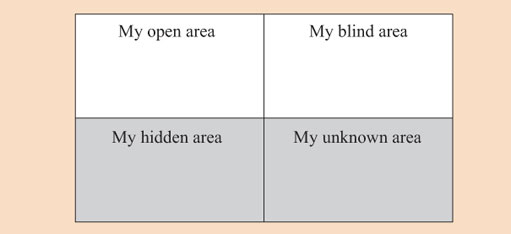2.3.1 Using the Johari Window
None of the Johari Window areas are fixed. Their contents change and the window areas change in size as we learn new things about ourselves and when we get feedback from others.
So, now it’s your turn to have a go! The next activity shows you how to do it.
Activity 4 Johari Window
Part 1
- Get a large sheet of paper and draw yourself a Johari Window diagram. You can create one on your computer if you are more comfortable with that. It should look something like Figure 6, with four headings as shown, and have space to write a few things in each box. (You do not have to make it particularly neat as you are going to change it soon by finding out new information about yourself.)
- Now, looking back through your learning journal, remind yourself of some of the qualities, knowledge and skills you identified for yourself earlier. It would be useful to think especially about those that might be useful for, or affect, your learning. Try to identify at least as many positive ones as those you are less confident about.
- Enter these into the open area and hidden area boxes of your Johari Window diagram where they fit best. Remember that the open area is for information you are happy to share (in this case with your mentor); the hidden area contains information that you are aware of, but which you prefer to keep to yourself (for example, perhaps a lack of confidence or a quality you’re not too proud of).
Discussion
This is the first step to completing the Johari Window – your own input. You should now put it aside until you do the next activity.
Of course, we may be happy to share specific pieces of information with some people and not others, so you may well want to adapt the contents depending on whom you ask to be your mentor.
But do note that if we share aspects of ourselves with others, it puts them in a better position to give us accurate (and more helpful) feedback; for example, saying you are not confident about something can prompt another person to reassure you about your skills or qualities. So the next stage is to ask your real or imaginary mentor to see if they can add anything to your window.
Part 2
This part of the activity has two options. You should choose just one of these:
Option 1: getting feedback from someone you know
Show the open area of your completed Johari Window to your chosen mentor. Ask them whether they can add any information about your qualities, knowledge or skills, and write it in your blind area box.
Option 2: getting some ‘imagined feedback’
Choose an imagined feedback-giver to sit in your ‘empty chair’. Think about what they might say in response to your current Johari Window open area. Might they add any additional qualities, skills or knowledge, or offer a new perspective? If so, add this to your blind area box.
Discussion
Did you learn anything new?
Once you have seen or heard feedback you can move this information from the blind to the open area because, of course, you and your mentor are now both aware of it and sharing it! (Albeit artificially with an imaginary mentor, but you can still learn from this.)
Perhaps you also decided to reveal something from your hidden area to help you get more useful feedback? If this happened to you, then some information will be ready to be moved from your hidden to your open area too.
While you are studying Succeed with learning, whenever you get additional information from your own reflection or from others’ feedback, you should revisit your Johari Window diagram. Change it so that it reflects the updated information about your skills and qualities. Perhaps your knowledge is increasing too?
You may want to change it now. If you are not sure what to do, look over this section again.

